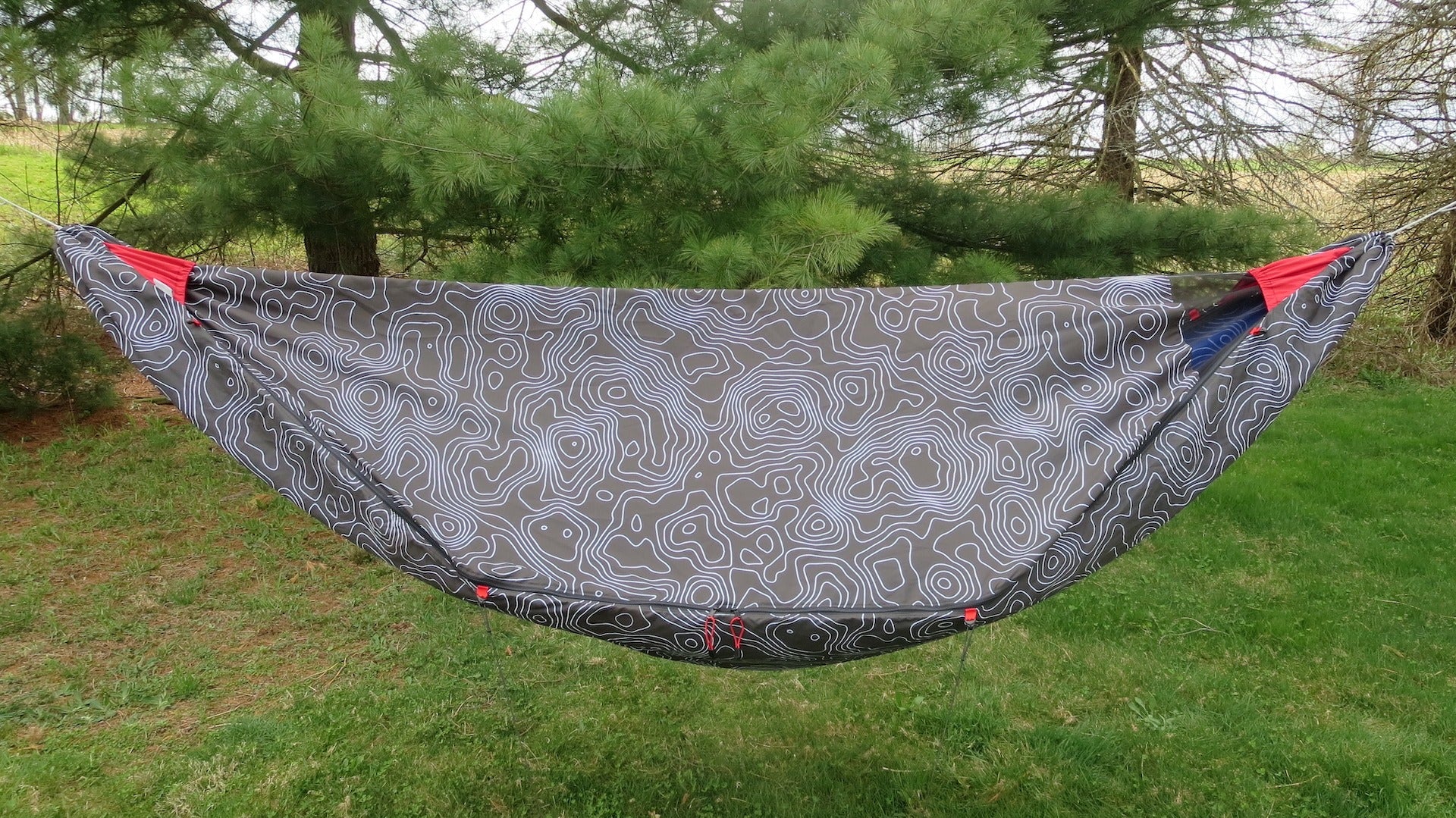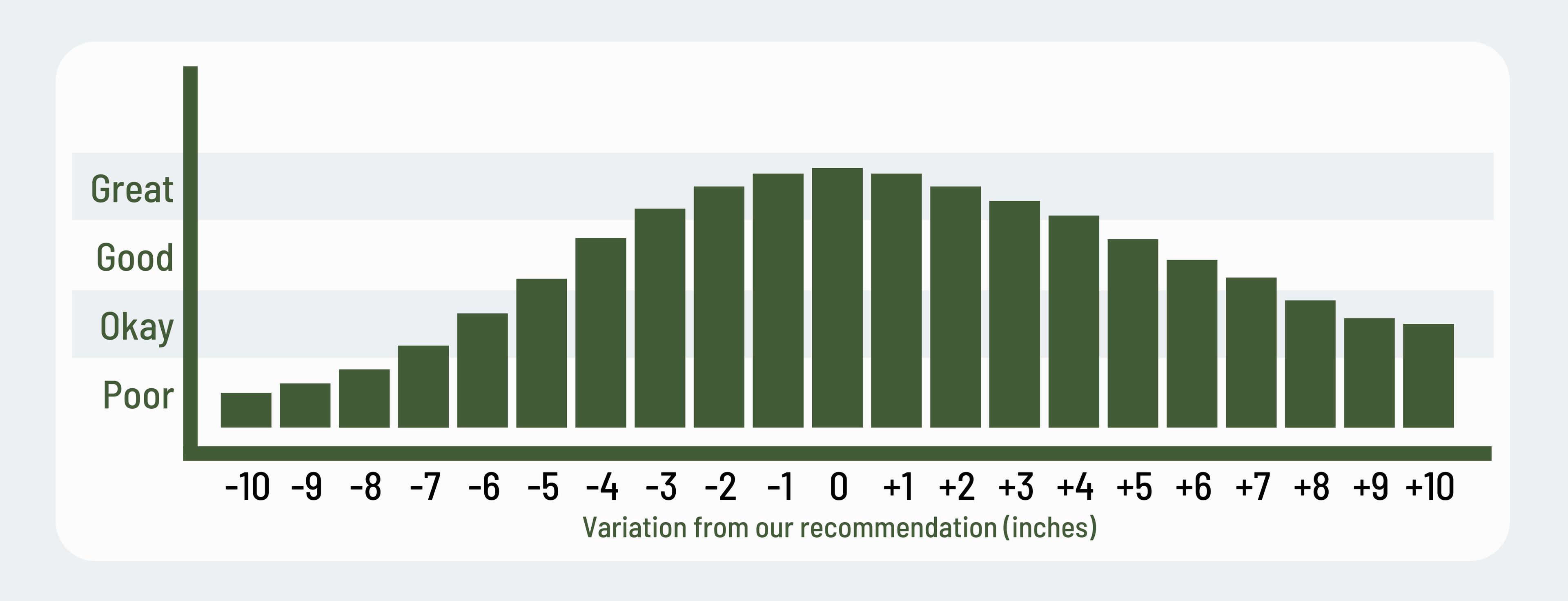
Hammock Size
The size of a hammock is one of the primary factors that will influence how comfortable it is. When buying a hammock, it's important to know what size you need. Luckily, you're in the right place!
What size should I get?
While a hammock’s size is very subjective, this guide will help you work through the different things one should consider when choosing a hammock’s size. When determining what size hammock you should get, there are two main factors: length and width. Before diving in, take a look at what size hammock we recommend for your height:
Sizing Chart
Feet & Inches
|
Your Height |
Hammock Length |
Hammock Width |
|
5’ 1” or shorter |
10’ |
58” |
|
5’ 2” |
10’ |
59” |
|
5’ 3” |
10’ |
60” |
|
5’ 4” |
10’ |
61” |
|
5’ 5” |
10’ |
62” |
|
5’ 6” |
11’ |
58” |
|
5’ 7” |
11’ |
59" |
|
5’ 8” |
11’ |
60" |
|
5’ 9” |
11’ |
61" |
|
5’ 10” |
11’ |
62" |
|
5’ 11” |
11’ |
63" |
|
6’ |
11’ |
65" |
|
6’ 1” |
11’ |
66" |
|
6’ 2” |
11’ |
68" |
|
6’ 3” |
11’ |
70" |
|
6’ 4” |
11’ |
71" |
|
6’ 5” |
11’ |
72" |
|
6’6” or taller |
12’ |
70-74" |
Centimeters
|
Your Height |
Hammock Length |
Hammock Width |
|
153 cm or shorter |
10’ |
58” |
|
157 cm |
10’ |
59” |
|
160 cm |
10’ |
60” |
|
163 cm |
10’ |
61” |
|
165 cm |
10’ |
62” |
|
168 cm |
11’ |
58” |
|
170 cm |
11’ |
59" |
|
173 cm |
11’ |
60" |
|
175 cm |
11’ |
61" |
|
178 cm |
11’ |
62" |
|
180 cm |
11’ |
63" |
|
183 cm |
11’ |
65" |
|
185 cm |
11’ |
66" |
|
188 cm |
11’ |
68" |
|
190 cm |
11’ |
70" |
|
193 cm |
11’ |
71" |
|
196 cm |
11’ |
72" |
|
198 cm or taller |
12’ |
70-74" |
What is the goal behind our suggested size?
The design and focus of our hammocks includes many different principles (such as trying to keep them light weight and making sure they are easy to use), but our chief concern is comfort - and our size chart is no different. Our size recommendations aim for a "sweet spot" - the ideal width for someone of that height. This should result in a hammock that is wide enough to make getting into a comfortable diagonal lay very easy, while still being narrow enough to prevent extra fabric that falls in on you or flap around in the breeze.
So with that being said, if your main priority is not comfort, you may find it suitable to alter the size. If you're an ultralight backpacker, shaving off a few inches from what we would normally recommend size might not be a bad idea.
So, It's okay to stray from our recommendation, right? Of course!
...but how far is too far?
How strictly should you follow the size chart?
Generally, the further you stray from what's recommended above, the more trouble you'll have. Chances are you won't even notice an inch or two, but 10" or 12" will make a noticeable difference.
The bottom line is this - I recommend sticking pretty close to what is shown on our size chart unless there you have a specific reason not to (Ready-to-Ship hammock not offered in that size, fabric width limitations, willing to sacrifice comfort for a lighter hammock, et cetra). At that point, you'll need to be the judge of how far you're willing to go outside of our recommendation.

-
Length
We consider a hammock’s length to be one of the most important factors in a hammock’s comfort. Our sizes provide a wide range of possibilities, allowing us to make a hammock tailored to your specific needs.
The length of your hammock is possibly one of the most important factors in determining a comfortable night's sleep. We have different hammock models available in 10ft, 11ft, and 12ft lengths.
-
Width
Our FabricsHammock width is another important contributor to the comfort of your hammock. A hammock's length will get you in the right ballpark, and the width allows you to fine-tune's the size to get the most comfortable hammock.
Our fabrics come in widths that allow us to build hammocks from 58" to 74" inches. To read more about this, see our Fabrics page.
-
Tip:
As a rule of thumb, it’s better to have a hammock that is slightly too wide rather than too narrow. Having a hammock that is too large can be a little annoying, but having a hammock that is too small can have negative effects on your comfort in the hammock. Ultimately though, It's best to get a hammock that fits your exact needs. We recommend going by our sizing chart, which should result in a good and comfortable hammock for you.
Too Wide:
- You will likely struggle to get lay in a good diagonal.
- Making a hammock too wide can cause extra fabric, which may hang loose and flap around.
- Your hammock will be heavier as a result of a wide hammock.
Too Narrow:
- Making a hammock too narrow can cause what is called “Shoulder Squeeze”, wherein the hammock puts pressure on your shoulders, making your hammock a bit uncomfortable.
- A hammock that is too narrow can also cause “Calf Ridge” because the hammock fabric isn’t wide enough to distribute your weight evenly across your hammock, resulting in a tight section of the hammock body will run along the back of your calf.
Other Considerations
-
What if I have broad shoulders or a smaller frame?
If you have a larger frame or a smaller frame, you may want to adjust the width of your hammock an inch or two wider or narrower to accommodate your body type. Our sizing chart was made with someone of average frame and weight in mind, so if you differ from that, feel free to tweak and personalize it to your needs.
-
Side Sleepers
Our FabricsFirst of all, many people who sleep on their side or stomach in a bed prefer to sleep on their back while in a hammock (I'm one of them!). So consider that before making any drastic changes because you sleep on your side in a bed.
That being said, if you do sleep on your side in your hammock, you will not need as wide of a hammock. Consider taking a few inches off our recommended size, but only a few so your hammock will still support a good diagonal lay.
Also, sleeping on your side creates pressure points at your hips and shoulders instead of distributing the weight evenly across your body. Because of this, you should consider a more supportive fabric. You can learn more about this on our fabric page.
